Beyond Knitting
Craft Paper and Glue Sticks: IKEA’s Magical Patterns
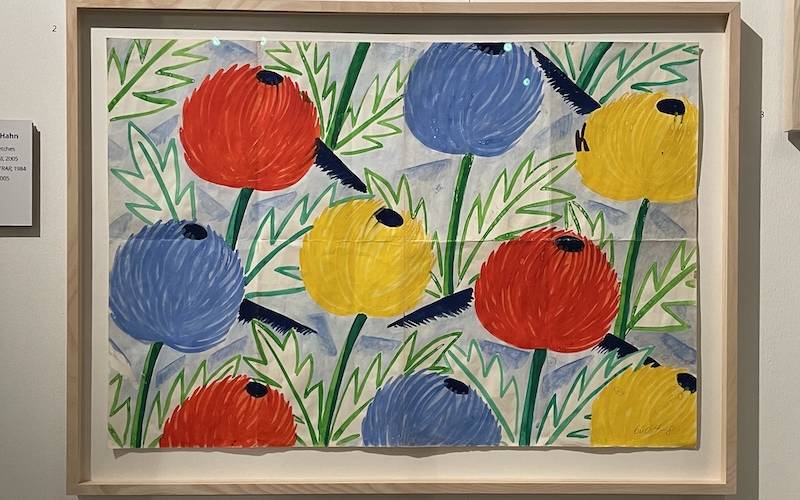
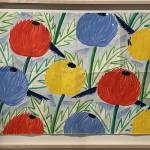
When you walk the labyrinthine aisles of IKEA, it’s easy to forget that the global homewares destination started somewhere with a single idea.
As you look for a new home for your Billy bookcase when you move across country or you decide to take that striped banana comforter from 1985 and back a quilt with it, you might not pause to consider how Billy and his banana friend came to exist in the first place.
They are just well-worn things with hopefully a bit more life in them.
The IKEA fabric canyons at Dovecot Studios.
Walking through IKEA: Magical Patterns at Dovecot Studios in Edinburgh, I learned that every single design at IKEA started with a person sitting at a table with a glue stick, watercolors, bits of colored paper, pencils, favorite postcards, and anything else that might inspire them.
That black and white striped banana fabric? Its designer Inez Svensson asked that it be draped over her coffin when she passed away at the age of 73.
RANDIG BANAN by Inez Svensson for IKEA, 1986.
Inez was one of dozens of designers who have defined the look of IKEA over the last sixty years. Crucially, she was a member of the textile design collective 10-gruppen (Ten Swedish Designers) who became core designers for IKEA in the 1970s and onward.
Inez “saw textile patterns as ‘the art of usefulness’ and felt they should be available to all.” She was part of the great Swedish movement to banish boring from household linens and put a work of art right on your bed or your throw cushion.
Inez and her fellow designers would never have had the backing of a global homeware company had it not been for a farm boy named Ingvar Kamprad who registered IKEA when he was seventeen. The company was named after himself, the farm he lived on, and the parish he came from: Ingvar Kamprad Elmtaryd Agunnaryd.
After a few years selling pens, watches and stockings, Ingvar Kamprad saw the potential of selling furniture by mail order. And thanks to his financial success with pens, he had a small amount of start-up capital. Soon the pens and watches went by the wayside and furniture with streamlined, quality production became his focus.
The furniture focused IKEA of 1965 before the colorful textile revolution.
Fast forward to the 1960s and the IKEA group started to realize that with furniture comes cushions, upholstery, curtains, pillows, sheets, towels, and duvet covers. Yep, we can thank the Swedes for the puzzle of getting the duvet into its cover without also putting ourselves into the cover.
Most Swedish home textiles in the early 1960s were heavy and grey or brown. IKEA took a risk and hired Inger Nilsson a woman with big ideas about color and cotton.
No more polyester, which had become the ubiquitous miracle fabric of the 40s, 50s, and 60s. Inger wanted big gingham checks in bright blue, whimsical clouds, and red and orange stripes all in washable cotton.
A selection of IKEA textile designs over the years.
By 1969, IKEA presented their first dedicated textile collection. By 1971 textiles comprised 25% of IKEA’s business. By 1973, that had jumped to 35%. What was once known as MOBEL-IKEA (Furniture-IKEA), dropped the MOBEL and just became IKEA all because of their groundbreaking textiles.
Pages from the 1969 IKEA catalog, courtesy of the IKEA museum.
Inger said that she would go speak to the woman in the curtain department in Älmhult. If they said, “We’ll never be able to sell this,” she knew it would be a hit.
After Inger retired, Vivianne Sjölin took the helm and soon had 2000 items in her inventory. She kept an eye on what sold and what didn’t, discontinuing items that didn’t move and finding designers who could create patterns and colors that the public loved.
Sjölin initiated IKEA’s collaboration with 10-gruppen and its members like Inez Svensson who created the legendary striped banana fabric.
Tom Hedqvist at 10-gruppen says, “We were a group of self-absorbed people who were really making patterns for ourselves. It was nice to see another way of doing things.” Ingela Hankansson Lamm continues, “We also felt accepted. It was the first time we could be part of the process. Vivianne had the same views as us and spoke the same language. That didn’t often happen.”
One of the most exciting aspects of the exhibition was seeing the original drawings and recreated mood boards of the designers who invented some of IKEA’s iconic designs. It was a pleasure to walk through the fabric archways and stand in fabric circles. There was even a sweet IKEA room with a comfy sofa and chair where visitors could sit, relax, and enjoy the patchwork of color.
Birgitta Hahn, mood board for 10-gruppen and IKEA, 1990.
IKEA continues to collaborate with designers. Most recently, they’ve sought out pink-haired, bedazzled, renowned British designer Zandra Rhodes who has brought her swirling, more-is-more aesthetic to play against IKEA’s streamlined Glostads and Kiviks.
A selection of designs from IKEA’s collaborations with Zandra Rhodes.
From those early days of big blue gingham checks and big orange flowers to the cute Brummig Bears of today, IKEA continues to seek out designers “to create a textile department worthy of the name.”
Cheers for designs made by real people holding a glue stick, paper, and scissors that one day might become our favorite blankets and pillows.
Header image credit: Birgitta Hahn, Aster, sketch for 10-gruppen and IKEA, 1988.

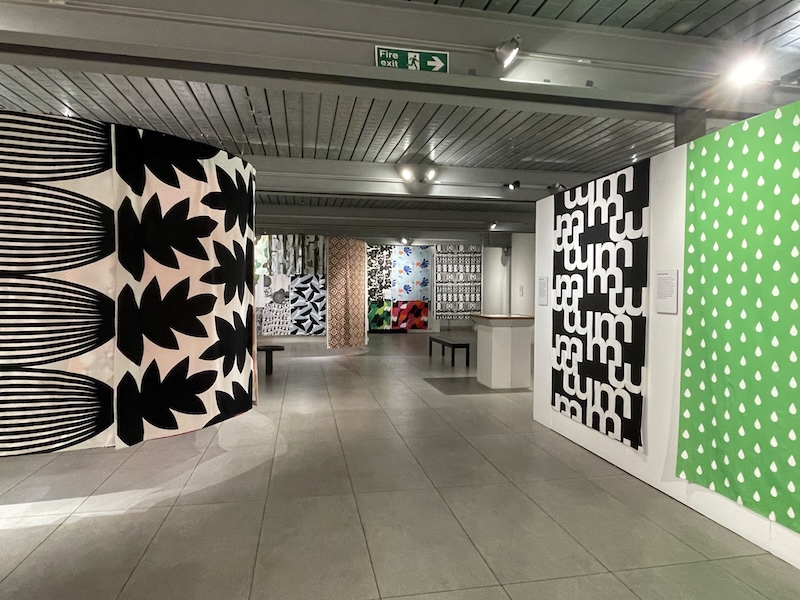
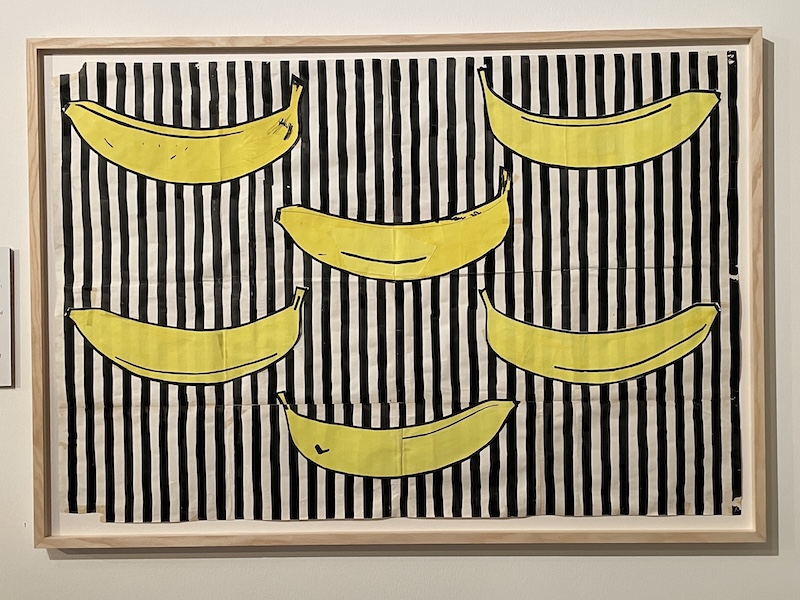
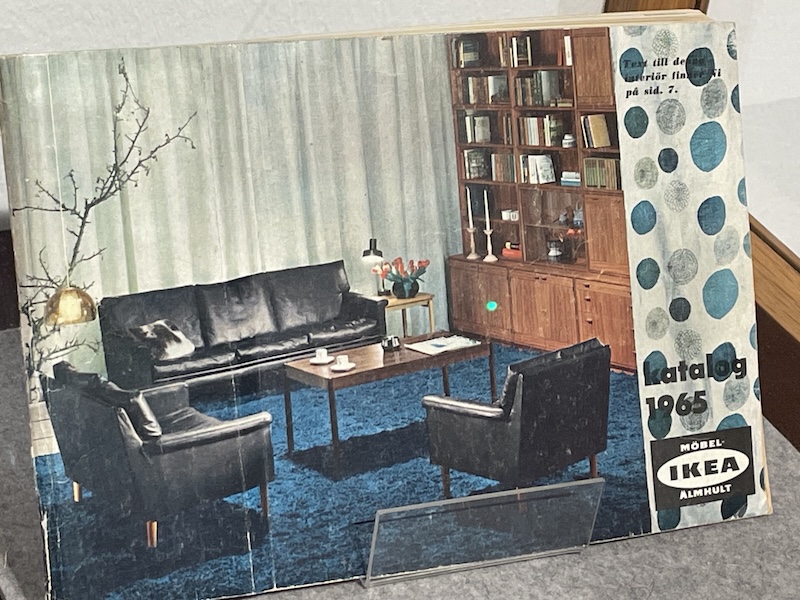
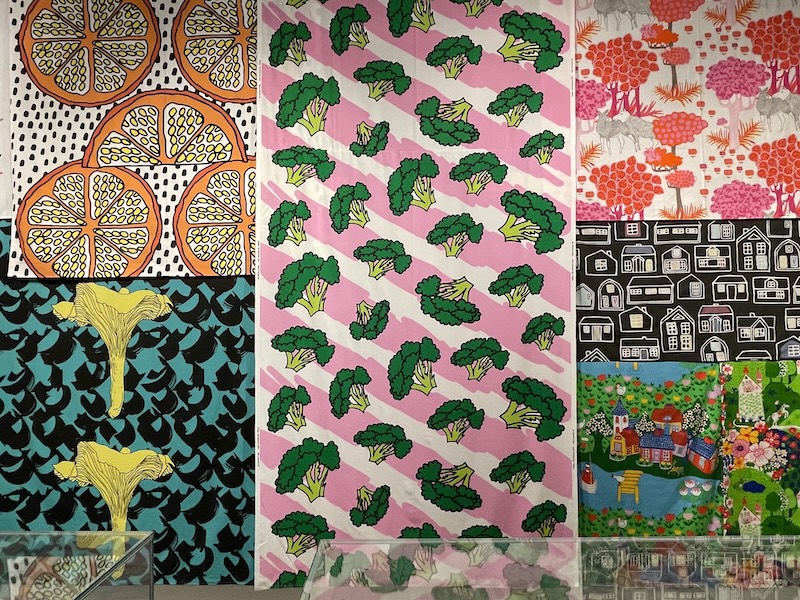
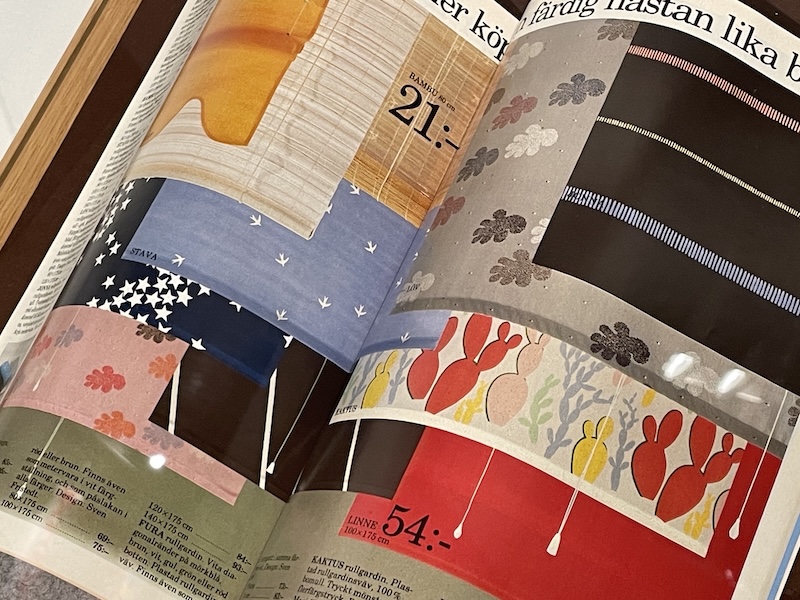
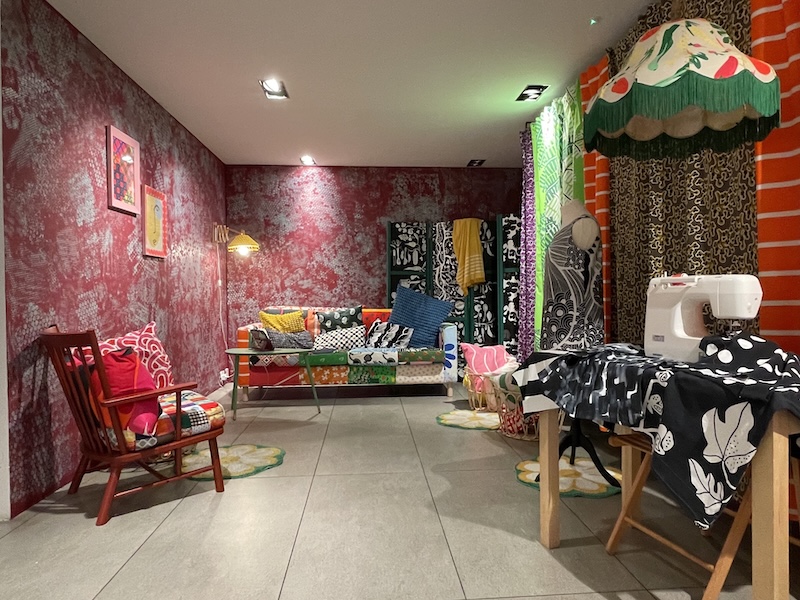

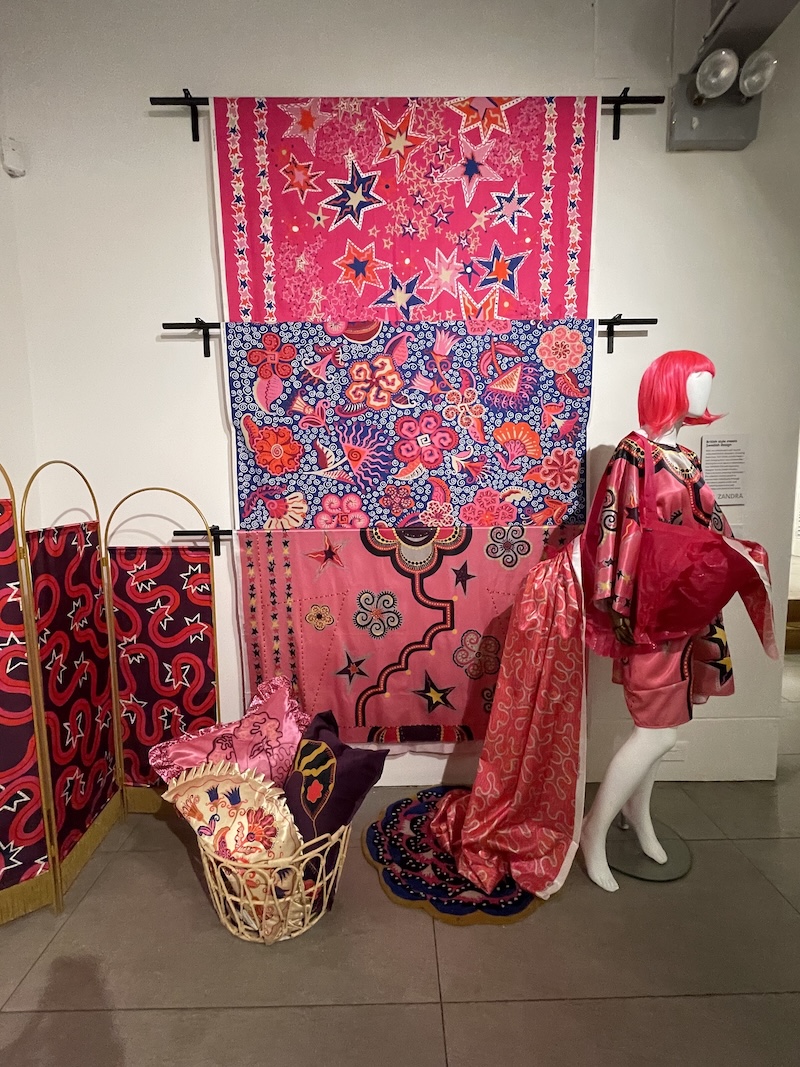

This story and these photos just made my day! I collect the IKEA fabrics and have a couple of yards of the bananas and the broccoli – so rare – and so many others from throughout the years. I sewed IKEA dresses, skirts and tops last summer and then made 10 different IKEA stockings with contrasting linings for the holidays. Sometimes I use the IKEA heavy pre-cut fabrics, but I also use duvet covers, pillow covers (which make great tote bags) and I’m making a pair of Sonya Phillip pants out of IKEA curtains right now. It’s become my new favorite side-hobby, next to knitting. (Not just sewing, but IKEA sewing.) Thank you for this morning stroll through the museum and IKEA’s textile history and stories from the artists who create these bold prints that I love so much. Glorious.
Dovecot Studio is one of my favourite memories of my recent trip to Shetland amd Edinburgh! I didn’t go to the IKEA exhibit (I was crunched for time, sadly) but I did venture upstairs to the viewing gallery to see their actual studio, which was incredible. Whatever is on there I highly recommend. The studio itself is in a lovely quiet spot only a short walk from the Royal Mile.
Sonya Phillip and IKEA – what a brilliant idea!
What a fabulous article! Thank you for reminding us how much IKEA has contributed to the colour in our lives! IKEA opened a store in the city where I lived in the late 70’s. I remember going with my Mom and Dad to see this New store. I was 15 at the time and we were moving. My parents bought me a new bed, my first down duvet, 2 duvet covers, a night table and a Billy bookcase. My Mom absolutely loved the duvet idea and it wasn’t long before every bed in the house had one…….no more time wasted on hospital corners for her( she had been a nurse so had done her fair share) ! I do remember quite a bit of swearing as my bed was assembled and it was forever missing one giant bolt, but I had that bed until just a few years ago! The quality of the fabric used in those years was also outstanding. I still have one of the duvet covers……..it is beautiful and soft and is still lovely after almost 50 years of use. My first apartment had Matisse and Picasso on the walls thanks to IKEA as well. When my children were young we were living in Germany and there was an IKEA close by. It became our go to place for lunch in the winter! I really enjoyed reading this article this morning. Thank you again!
I had no idea of the history behind their textiles – this was so much fun!
Nice! New info on a name- that’s an acronym! Deep design dishing. Thank you.
Oh Jeni, thank you for another wonderful letter. IKEA’s story is fascinating!
Dovecote was one of the highlights of Edinburgh for me, thanks for taking me back.
Another great post this morning – I knew very little about IKEA’s history and their fabric design process and this was a very interesting read!
What a wonderful essay! I’ve always had issues trying to navigate an IKEA store (how do I get back to such and such section?); this was a delightful read. Thank you!
Before they were called ‘duvets’ they were merely quilt covers. Purchased, or made from two flat sheets.
Of course, once they were renamed duvets they cost more. I have some in my linen closet that are older than IKEA.
Do love their natural fabrics, though sadly they have more things w poly-type blends now. And all kids loved the ball pit…
Dovecot Studio is one of my favourite memories of my recent trip to Shetland amd Edinburgh! I didn’t go to the IKEA exhibit (I was crunched for time, sadly) but I did venture upstairs to the viewing gallery to see their actual studio, which was incredible. Whatever is on there I highly recommend. The studio itself is in a lovely quiet spot only a short walk from the Royal Mile.
Well, that was a fun read! Who knew? I had no idea of the “colorful” history of IKEA – from the name to the designs! Wonderful words and pictures. Thanks for sharing a bit of your trip with us!
Great article. The power of the glue stick! I have used ikea fabric to make pants and pillows and pre k curtains! And one of my favorite tote bags was made from fabric that was made by one of their Asian designers and I snagged it a long time ago. Get it when you can.
What a fun and colorful read. Thank you Jeni. I have been interested in textiles since high school and made a living designing and selling contract textiles for 40 years, but I never heard a peep about the important part IKEA played in making our lives colorful as well as useful. Long live IKEA!
Thank you for this informative article about textile angle of my trusty furniture store.
Aaah – ikea’s fabrics… too bad they are more of a memory as their offerings seem to be shrinking as there are less and less people who sew. They even had sewing machine corner in most stores, where one could use them if they did not have one at home! These are now gone along with the array of designs one could chose from.
Their patterns reminded me of Marimekko – and in some way Swatch watches seem to come from similar inspiration cross-polination…
Thank you for this informative article about my trusty furniture store!
No wonder I didn’t see any fabrics at Ikea – I just made my first visits there this month.
And yes, their designers do seem to have been influenced by Marimekko, which long preceded them.
Thank you for this informative article about textile angle of my trusty furniture store.
Aaah – ikea’s fabrics… too bad they are more of a memory as their offerings seem to be shrinking as there are less and less people who sew. They even had sewing machine corner in most stores, where one could use them if they did not have one at home! These are now gone along with the array of designs one could chose from.
Their patterns reminded me of Marimekko – and in some way Swatch watches seem to come from similar inspiration cross-polination…
This was really informative. We have an IKEA store coming next spring (first one in our state) and I hope they’ll have some if the fabrics on display.
Thanks for the lesson on IKEA’s textiles history! Very interesting read. I always enjoy your missives!
Thank you! Fascinating!
Visiting Scotland on vacation and have a free afternoon in Edinburgh today. I had already planned to visit Dovecot, and now sitting at lunch, I’ve bought tickets and we are heading there next!!
I was unaware of the great textile history of Ikea. Thanks for another fun ramble through a gallery!
Dovecot sometimes has online tours of the physical tours. I watched one just this week on the Ikea exhibit. If you sign up for their emails (at Dovecotstudios.com), they’ll let you know when tours are available.
Loved this look back on IKDA
Thank you
Are the glue sticks vegan
Love all this. It is amazing!
So interesting, Jeni. What a lush array of fabrics. I do like to stop by the textile department when I go to Ikea. It seems like most people pass it by! Always something interesting there.
Thanks for being our eyes and feet in locations not easily accessible for many of us. Enjoy the history, commentary and photos. Fascinating insight into this aspect of IKEA.